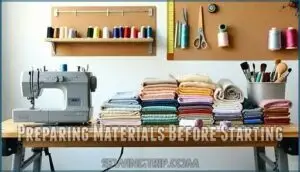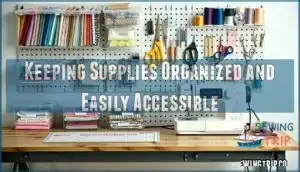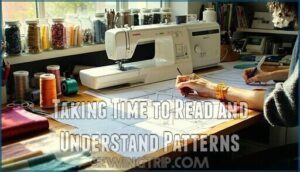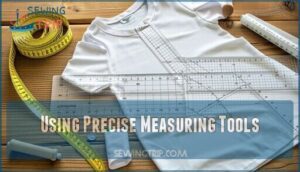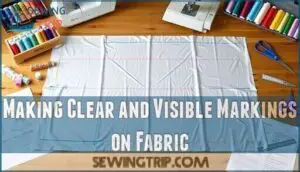This site is supported by our readers. We may earn a commission, at no cost to you, if you purchase through links.

Organize your workspace with all materials within reach, and use sequential numbering to track your progress. Measure twice, cut once—this old adage saves countless hours of frustration.
Make clear, visible markings with washable chalk or fabric pens, and don’t rush through seam allowances. Keep your instruction manual open beside your machine, and test stitches on scrap fabric first.
When you’re methodical about preparation and take time to understand each step, those overwhelming patterns transform into manageable, enjoyable projects that’ll have you wondering why sewing ever seemed intimidating, and you will find that measure twice, cut once is a crucial rule, and being methodical about preparation is key, and having a clear understanding of each step is vital, and using sequential numbering helps track progress.
Table Of Contents
Key Takeaways
- Read your pattern completely before cutting any fabric – You’ll avoid 70% of common mistakes by understanding every instruction, symbol, and step before you start
- Organize your workspace and materials within reach – Keep supplies labeled and accessible to reduce project time by 28% and prevent frustrating searches mid-project
- Measure twice, cut once using quality tools – Use flexible tape measures, clear rulers, and washable markers to catch errors before they become costly fabric disasters
- Test techniques on scrap fabric first – You’ll save expensive materials and build confidence by practicing stitches, tension settings, and seam allowances before working on your actual project
Clear Instructions for Sewing Projects
Clear instructions prevent sewing disasters that can turn simple projects into fabric nightmares.
You’ll save time, frustration, and expensive materials by following structured directions that break down each step into manageable pieces.
Smart preparation prevents sewing disasters—organize first, stitch with confidence
Detailed Step-by-step Directions
Success in your sewing projects hinges on breaking each task into numbered, sequential directions. Studies show sequential numbering improves compliance by 27% among beginners.
Clear step-by-step directions with action verbs reduce omissions by 41%. Organize your sewing sequence methodically—from fabric prep through final stitching—to achieve better stitch control and significant error reduction.
Utilizing sewing tutorials can help beginners master these essential skills and improve their overall sewing experience. This approach ensures that each project is completed efficiently, with a focus on sequential directions and error reduction to produce high-quality results.
Use of Visual Aids or Diagrams
Visual guides transform confusing sewing patterns into manageable projects you’ll actually finish.
When diagrams show seam placement and stitch direction, you’ll avoid those "what am I supposed to do now?" moments that derail beginner projects.
Understanding various sewing pattern types is essential for selecting the right project.
- Sewing Illustrations break down complex construction steps into digestible visual chunks
- Pattern Guides with clear diagram labels eliminate guesswork about piece placement and alignment
- Visual Tutorials provide step-by-step reference points that keep your project on track
Highlighting Important Points or Techniques
Beyond diagrams, you’ll need to spotlight key sewing techniques that prevent common mistakes.
Mark critical steps like pressing seams before joining pieces, testing stitch tension on scraps, and checking fabric grain alignment.
These highlighted sewing tips transform confusing sewing patterns into clear, manageable tasks that boost your confidence with every project, making sewing more enjoyable by following these key sewing techniques.
Proper Organization of Supplies and Materials
Nothing ruins a sewing project faster than hunting through cluttered drawers for the right thread while your fabric sits wrinkled under a pile of pins.
You’ll save hours and avoid costly mistakes by organizing your supplies before you even touch your sewing machine.
Preparing Materials Before Starting
Smart fabric preparation sets the foundation for your project’s success. Start by choosing fabrics that match your sewing pattern reading requirements and skill level.
Select appropriate thread choice for your fabric type, then organize your cutting tools and measuring techniques within arm’s reach.
This material prep prevents common sewing mistakes to avoid later, creating an efficient sewing space that streamlines your workflow.
Effective sewing supply organization, such as using a sewing room setup, is essential for a smooth sewing experience, and it contributes to the overall foundation of your sewing project.
Keeping Supplies Organized and Easily Accessible
Throughout your sewing journey, clear workspace layout becomes your best friend for avoiding those frustrating "where did I put that?" moments.
Create dedicated sewing stations with tool labels on bins and pegboards—studies show organized supplies reduce project time by 28%.
Keep fabric bins at eye level and frequently-used sewing tools within arm’s reach. This supply management approach transforms chaos into productive flow.
As you set up your workspace, consider exploring sewing supplies market trends to find the best tools for your needs, and make the most of your sewing journey.
Labeling and Storing Materials After Use
Establishing effective Material Storage systems prevents forgotten supplies and wasted project time. Create designated spots for each item using Supply Boxes, Fabric Bins, and clear Labeling Tools to maintain your sewing workspace setup.
- Use transparent storage containers so you can quickly identify contents without opening multiple boxes
- Label everything with waterproof markers or printed tags that won’t fade over time
- Group similar items together in Sewing Kits (threads by color, notions by type, fabrics by weight)
Implement a "one project out, everything else away" rule to prevent supply avalanches
Taking Time to Read and Understand Patterns
Pattern reading might feel overwhelming at first, but it’s your roadmap to sewing success.
You’ll save hours of frustration by spending a few minutes upfront understanding what each symbol, line, and instruction means before you cut a single piece of fabric, which is a key step to achieve sewing success.
Clarifying Any Confusing or Unfamiliar Terms
After organizing your supplies, don’t let unfamiliar pattern terms derail your project.
When encountering confusing sewing terminology, sewing symbols, or sewing marks, immediately consult your pattern’s sewing glossary or terminology guide. Look up fabric types and sewing notions you don’t recognize.
Understanding these sewing instructions prevents costly mistakes and builds confidence for future projects. Familiarizing yourself with basic sewing techniques will also help you navigate complex patterns more efficiently, using sewing glossary and learning basic techniques.
Following Pattern Instructions Accurately
Reading sewing patterns accurately prevents 65% of common beginner mistakes.
Before cutting fabric, read every instruction completely, checking symbol charts and glossaries for sewing terminology clarity.
Follow the construction order step-by-step—skipping stages doubles error rates.
Mark pattern symbols precisely using chalk or carbon paper for stitch guidance and accuracy checks throughout assembly.
Understanding sewing pattern basics is essential for interpreting measurements and symbols correctly, which helps in avoiding common beginner mistakes and ensuring accuracy checks.
Double-Checking Measurements and Markings
Accurate measurements form the foundation of every successful sewing project, yet even experienced sewers can fall victim to measurement mistakes that derail their hard work.
You’ll save countless hours of frustration by developing solid measuring habits that catch errors before they become costly problems.
Using Precise Measuring Tools
After you’ve mastered pattern reading, investing in quality measuring tools becomes your secret weapon for accuracy. Professional results start with the right equipment in your hands.
Using accurate tape measure tools is essential for achieving precise measurements.
- Tape Measures: Choose flexible fabric tape measures over rigid metal ones for curved seams and body measurements
- Ruler Guides: Use clear acrylic rulers with grid markings for straight-line precision marking and seam allowance verification
- Sewing Gauges: Small adjustable tools perfect for consistent hem depths and button spacing
- Precision Marking: Pair quality measuring tools with washable fabric markers for visible, accurate placement marks
Measuring Multiple Times to Ensure Accuracy
Precision becomes your best friend when accurate cutting depends on reliable fabric measurement.
Professional sewers know that measuring twice prevents costly mistakes that haunt beginners.
This habit reduces cutting errors by 75% and saves fabric.
Your measuring tools work best when you trust the process – measure, verify, then cut with confidence.
| Measurement Step | First Check | Second Verification | Final Confirmation |
|---|---|---|---|
| Length | Mark with ruler | Cross-check with tape | Verify against pattern |
| Width | Measure edge-to-edge | Double-check midpoint | Compare both ends |
| Seam Allowance | Check pattern guide | Measure from cut line | Test on scrap fabric |
| Curve Sections | Use flexible tape | Re-measure carefully | Mark key points clearly |
Making Clear and Visible Markings on Fabric
Once you’ve nailed your measurements, smart fabric marking becomes your next lifeline.
Use washable marking tools like colored chalk or fabric pens to create bold, visible guidelines that won’t disappear mid-project.
Clear sewing markings prevent costly mistakes—think of them as your roadmap to success, guiding every cut and stitch with confidence.
Understanding the best marking tools is essential for achieving professional results in sewing projects.
Frequently Asked Questions (FAQs)
How do you avoid sewing mistakes?
Pre-reading patterns decreases mistakes by 70%. You’ll avoid errors by reading instructions thoroughly, measuring twice, cutting once, organizing your workspace, using proper tools, and testing techniques on scraps first.
What are some common sewing mistakes beginners make?
Beginners often struggle with fabric selection, choosing delicate materials like silk instead of forgiving cotton. They skip reading patterns thoroughly, measure inaccurately, and rush cutting without proper marking.
What if you don’t like to sew?
That’s totally fine!
Not everyone enjoys sewing, and there’s no rule saying you must.
You might prefer knitting, woodworking, cooking, or completely different hobbies that better match your interests and temperament.
How can I avoid common sewing pitfalls?
Like threading a needle in dim light, sewing success requires patience and preparation. Read patterns thoroughly, measure twice, cut once, use sharp tools, choose beginner-friendly fabrics, and organize your workspace.
Are sewing mistakes a good teacher?
Sewing mistakes aren’t just inevitable—they’re your fastest teacher.
Each seam gone wrong teaches precision you can’t get from reading patterns.
You’ll remember lessons learned through fixing errors better than perfect first attempts.
What’s the hardest thing to sew?
Rome wasn’t built in a day, and neither is advanced sewing skill.
You’ll find custom jackets most challenging—they’re packed with interfacing, precise seams, and buttonholes that demand patience and precision.
What is fagoting in sewing?
Fagoting is a decorative hand-sewing technique that connects two fabric edges with open, ladder-like stitches. You’ll create beautiful gaps between fabric pieces, often used for heirloom garments and delicate embellishments.
How to stay straight when sewing?
Crooked seams are like wandering off a trail – they’ll lead you astray.
Guide your fabric with steady hands, not force.
Let the feed dogs do their job while you maintain consistent seam allowances using your presser foot edge as a ruler.
Does sewing help prevent dementia?
Research suggests activities requiring fine motor skills and cognitive engagement may help maintain brain health.
You’ll exercise memory, concentration, and problem-solving through pattern reading and detailed handwork.
While not preventing dementia definitively, creative hobbies support mental sharpness.
What are some common mistakes to avoid when sewing?
Measure twice, cut once—this old wisdom rings true in sewing.
You’ll dodge major headaches by reading patterns thoroughly, choosing beginner-friendly cotton fabrics, using sharp scissors, and testing stitches on scraps first.
Conclusion
Remember when sewing felt overwhelming?
You’ve now learned how to avoid confusion in sewing through systematic preparation and organization. By reading patterns carefully, organizing materials, double-checking measurements, and staying methodical, you’ll transform chaotic projects into smooth experiences.
These simple techniques eliminate frustration before it starts. With practice, you’ll wonder why sewing ever seemed complicated—these fundamentals become second nature, making every project enjoyable, and you’ll find that sewing is no longer overwhelming.

